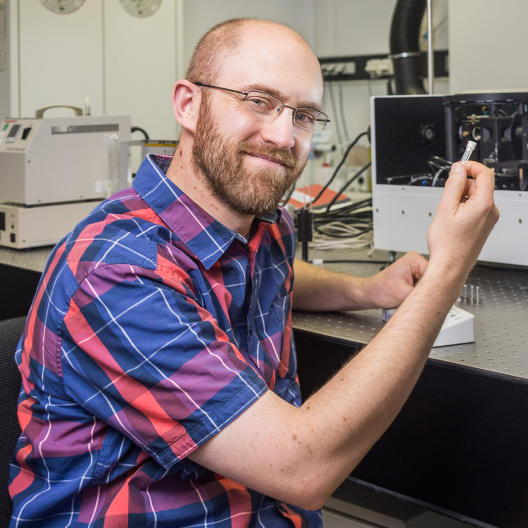“Luminescence is a fascinating phenomenon”

Professor Strassert, what scientific topic are you working on at the moment?
Essentially, we are interested in the interaction between light and matter. As a chemist I deal with so-called coordination compounds, with emphasis on transition metal complexes. When these compounds are excited, they convert into signals the energy they have absorbed. Such processes are relevant not only to display and illumination technologies, but also to molecular imaging and phototherapy in biomedicine. We’re currently developing special molecules which we want to use to visualize and possibly also to treat diseases. To take an example, we’re interested in antibiotic-resistant diseases, for it’s still extremely difficult to detect and eliminate bacterial infections without killing host tissues. We’d like to use some of our synthesized molecules to visualize and kill off dangerous germs. An antibiotic triggered with meticulous precision by a ray of light is to be attached to bacteria or bacterial biofilms. The latter are to be labelled by luminescence, and some of the energy that has been absorbed is to be transferred to the ambient oxygen, which will then become so highly reactive that it will attack and exterminate germs. We’d also like to use molecules to visualize bacteria and biofilms by means of luminescence or photoacoustic imaging. When we excite with a pulsed beam of light, this causes the molecules in the tissue to covert the absorbed energy into heat. The energy released in this way can be detected as an acoustic wave by ultrasound.
What characterizes you personally as a scientist?
I think I’m very determined. When something isn’t working properly, then I get really attentive. For instance, I may be baffled when a molecule fails to emit light while carrying out our measurements. As a child I was consumed with curiosity. I would take toys apart to find out what made them work. In the kitchen I would carry out experiments with simple chemicals, and in the attic, I would busy myself with a soldering iron and electronic circuits. I have an interdisciplinary background: I’m both a pharmacist and a chemist, I have a PhD in organic chemistry, I did post-doctoral research at the physics department, and I currently hold a professorship in inorganic chemistry. This has enabled me to acquire a certain “linguistic” competences which facilitates cross-disciplinary activities. I really enjoy swapping ideas with co-operation partners. We learn a lot from each other and develop things together.
What is your greatest aim as a scientist?
Resistance to antibiotics and biofilms are problems in which I have a keen interest. I believe that humanity is going to be confronted with a major issue if antibiotics continue to prescribed in an irresponsible manner. To make matters worse, in some countries antibiotics can be obtained without a prescription, and they’re often used in intensive livestock farming. I’m also keenly interested in the diagnosis and treatment of cancer, and I hope that my research will ultimately help these patients. Although our team is mainly interested in coordination chemistry, we always bear in mind the practical applications of our research. The fact that I originally qualified as a pharmacist keeps me thinking about these topics.
What’s your favourite research ‘toy’, and what can it do?
My favourite research toy is the fluorescence spectrometer. Without this instrument half of our work would be impossible. The spectrometer can tell us how long molecules remain in an excited state, how much energy they can absorb or give off, and how efficiently they do this. It also tells us whether molecules decompose when they are excited by light. We’re going to try to hook the spectrometer up with a fluorescence microscope. When we receive and see signals under the microscope, we’ll transfer them via an optical fibre to the spectrometer, where we’ll be able to subject them to precise scrutiny.
Which scientific phenomenon still regularly fascinates you today?
Luminescence. Luminescent molecules and the quantum mechanics behind it. I’m awestruck by all these things. Generally speaking, I’m also fascinated by the emission of other kinds of electromagnetic radiation (e.g. from radioactive materials). Tiny particles which are in an excited state relax, emitting a photon which can be perceived by the eye or by other detectors.
What big scientific question would you like to have an answer to?
The origin of life. The diversity of living organisms is simply fascinating: viruses, bacteria, fungi, protozoa, insects, algae, animals, cancerous cells... We scientists are continually confronted with challenges when we try to functionalize nanoparticles or molecules intelligently, only to find that things frequently don’t go according to the original plan. I never cease to wonder at the fact that certain organisms can capture and store light in chemicals, thereby providing the basis for our food and our sources of energy. Once you’ve grasped these fundamental aspects of nature, you can achieve a better understanding of the various ways in which cells, organs or organisms can be healed or guided with the aid of light.
How much artistry, creativity and craftsmanship is there in your scientific work?
Our discipline requires a great deal of technical dexterity. If the people who work in the synthesis laboratory aren’t properly qualified, they may, in a worst case scenario, poison themselves or cause an explosion. One might add that making precise measurements with an instrument such as the spectrometer is an art in itself. Our work takes on an aesthetic and artistic dimension when a lot of molecules glow or absorb at different colours. Light, acoustics, and chemical compounds with heavy metals – that even has something to do with music, my secondary passion.

